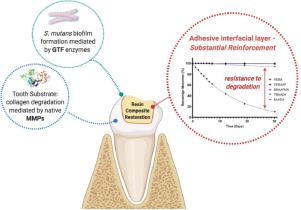Acta Biomaterialia ( IF 9.4 ) Pub Date : 2020-08-24 , DOI: 10.1016/j.actbio.2020.08.026 A P P Fugolin 1 , Oscar Navarro 1 , Matthew G Logan 1 , Vincent Huynh 1 , Cristiane M França 1 , Jack L Ferracane 1 , Carmem S Pfeifer 1

|
Purpose/aim
In an attempt to increase the service life of dental adhesive interfaces, more hydrolytically and enzymatically-stable methacrylate alternatives, such as methacrylamides, have been proposed. The aim of this study was to investigate polymerization behavior, as well as mechanical and biological properties of experimental adhesives containing multi-functional acrylamides.
Materials and methods
Multi-functional acrylamides (N,N-Bis[(3-methylaminoacryl)propyl]methylamine - BMAAPMA, Tris[(2-methylaminoacryl)ethyl]amine - TMAAEA, N,N’-bis(acrylamido) 1,4-diazepane - BAADA, N,N-Diethyl-1,3-bis(acrylamido)propane - DEBAAP) or HEMA (2-Hydroxyethyl methacrylate - control) were added at 40 wt% to UDMA. 0.2 wt% DMPA and 0.4 wt% DPI-PF6 were used as initiators. Polymerization kinetics was followed in real-time in near-IR during photoactivation (320–500 nm, at 630 mW/cm2). Water sorption/solubility and flexural strength/modulus were measured according to ISO 4049. 1H NMR was used to assess monomer degradation kinetics. MTT assay was used to assess cytotoxicity against OD-21 and DPSC cells. Biofilm formation and adhesion were assessed by Luciferase Assay and Impingement technique, respectively. Solvated adhesives (40 vol% ethanol) were used to test interfacial adhesion strength. The results were analyzed by ANOVA/Tukey's test (α = 0.05).
Results
In general, the pure methacrylate mixture had higher rate of polymerization (Rpmax), degree of conversion (DC) at Rpmax, and final DC than the acrylamides. Flexural properties after water storage decreased between 11 and 65%, more markedly for acrylamides. Interfacial bond strength was greater and more stable long-term for the newly synthesized acrylamide formulations (less than 4% reduction at 6 months) compared to the methacrylate experimental control (42% reduction at 6 months). HEMA degraded by almost 90%, while the acrylamides showed no degradation in acidic conditions. Cytotoxicity and biofilm formation, in general, were similar for all groups.
Conclusions
Despite demonstrating high water sorption, the acrylamide-containing materials had similar mechanical and biological properties and enhanced interfacial bond strength stability compared to the methacrylate control.
中文翻译:

具有叔胺核的二丙烯酰胺和三丙烯酰胺的合成及其作为牙科粘合剂界面中的单体的评价。
目的/目的
为了增加牙科粘合剂界面的使用寿命,已经提出了更水解和酶促稳定性的甲基丙烯酸酯替代品,例如甲基丙烯酰胺。本研究的目的是研究含有多功能丙烯酰胺的实验粘合剂的聚合行为以及机械和生物性能。
材料和方法
多功能丙烯酰胺(N,N-双[(3-甲基氨基丙烯酰)丙基]甲胺 - BMAAPMA,三[(2-甲基氨基丙烯酰)乙基]胺 - TMAAEA,N,N'-双(丙烯酰胺)1,4-二氮杂 - BAADA、N,N-二乙基-1,3-双(丙烯酰胺基)丙烷-DEBAAP)或HEMA(甲基丙烯酸2-羟基乙酯-对照)以40wt%添加到UDMA中。0.2 wt% DMPA 和 0.4 wt% DPI-PF6 用作引发剂。在光活化(320-500 nm,630 mW/cm 2)期间,在近红外中实时跟踪聚合动力学。水吸附/溶解性和挠曲强度/模量根据ISO 4049测得的1H NMR 用于评估单体降解动力学。MTT测定用于评估对OD-21和DPSC细胞的细胞毒性。分别通过荧光素酶测定和撞击技术评估生物膜形成和粘附。溶剂化粘合剂(40 vol% 乙醇)用于测试界面粘合强度。结果通过 ANOVA/Tukey 检验 (α = 0.05) 进行分析。
结果
通常,纯甲基丙烯酸酯混合物比丙烯酰胺具有更高的聚合速率 (Rp max )、在 Rp max下的转化度 (DC)和最终 DC。水储存后的弯曲性能下降了 11% 到 65%,丙烯酰胺的下降幅度更大。与甲基丙烯酸酯实验对照(在 6 个月时降低 42%)相比,新合成的丙烯酰胺配方的界面结合强度更大且长期更稳定(6 个月时降低小于 4%)。HEMA 降解了近 90%,而丙烯酰胺在酸性条件下没有降解。一般来说,所有组的细胞毒性和生物膜形成都相似。
结论
尽管表现出高吸水性,但与甲基丙烯酸酯对照物相比,含丙烯酰胺的材料具有相似的机械和生物特性以及增强的界面结合强度稳定性。











































 京公网安备 11010802027423号
京公网安备 11010802027423号